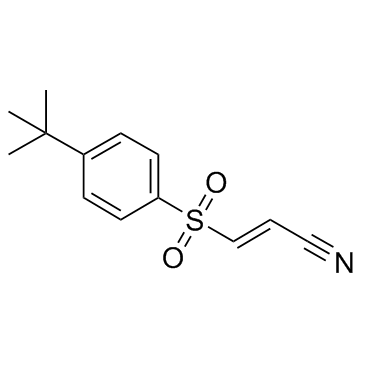Bay 11-7085

Bay 11-7085 structure
|
Common Name | Bay 11-7085 | ||
|---|---|---|---|---|
| CAS Number | 196309-76-9 | Molecular Weight | 249.329 | |
| Density | 1.1±0.1 g/cm3 | Boiling Point | 407.1±45.0 °C at 760 mmHg | |
| Molecular Formula | C13H15NO2S | Melting Point | 80-82℃ | |
| MSDS | Chinese USA | Flash Point | 200.0±28.7 °C | |
|
Infection of human amniotic and endothelial cells by Japanese encephalitis virus: Increased expression of HLA-F.
Virology 471-473 , 29-37, (2015) Productive infection of human amniotic and endothelial cell lines with Japanese encephalitis virus (JEV) was established leading to the induction of NFκB and HLA-F, a non-classical MHC molecule. Induction of the HLA-F gene and protein in JEV-infected cells wa... |
|
|
High-content positional biosensor screening assay for compounds to prevent or disrupt androgen receptor and transcriptional intermediary factor 2 protein-protein interactions.
Assay Drug Dev. Technol. 12(7) , 395-418, (2014) The androgen receptor-transcriptional intermediary factor 2 (AR-TIF2) positional protein-protein interaction (PPI) biosensor assay described herein combines physiologically relevant cell-based assays with the specificity of binding assays by incorporating str... |
|
|
Vascular wall hypoxia promotes arterial thrombus formation via augmentation of vascular thrombogenicity.
Thromb. Haemost. 114 , 158-72, (2015) Atherosclerotic lesions represent a hypoxic milieu. However, the significance of this milieu in atherothrombosis has not been established. We aimed to assess the hypothesis that vascular wall hypoxia promotes arterial thrombus formation. We examined the relat... |
|
|
Aspirin-induced histone acetylation in endothelial cells enhances synthesis of the secreted isoform of netrin-1 thus inhibiting monocyte vascular infiltration.
Br. J. Pharmacol. 172 , 3548-64, (2015) There are conflicting data regarding whether netrin-1 retards or accelerates atherosclerosis progression, as it can lead either to monocyte repulsion from or retention within plaques depending on its cellular source. We investigated the effect of aspirin, whi... |
|
|
Two High Throughput Screen Assays for Measurement of TNF-α in THP-1 Cells.
Curr. Chem. Genomics 5 , 21-9, (2011) Tumor Necrosis Factor-α (TNF-α), a secreted cytokine, plays an important role in inflammatory diseases and immune disorders, and is a potential target for drug development. The traditional assays for detecting TNF-α, enzyme linked immunosorbent assay (ELISA) ... |
|
|
Increasing expression of substance P and calcitonin gene-related peptide in synovial tissue and fluid contribute to the progress of arthritis in developmental dysplasia of the hip.
Arthritis. Res. Ther. 17(1) , 4, (2015) Developmental dysplasia of the hip (DDH) is a common musculoskeletal disorder that has pain and loss of joint function as major pathological features. In the present study, we explored the mechanisms of possible involvement and regulation of substance P (SP) ... |
|
|
Plexin-B1 activates NF-κB and IL-8 to promote a pro-angiogenic response in endothelial cells.
PLoS ONE 6(10) , e25826, (2011) The semaphorins and their receptors, the plexins, are proteins related to c-Met and the scatter factors that have been implicated in an expanding signal transduction network involving co-receptors, RhoA and Ras activation and deactivation, and phosphorylation... |
|
|
The p110α and p110β isoforms of class I phosphatidylinositol 3-kinase are involved in toll-like receptor 5 signaling in epithelial cells.
Mediators Inflamm. 2010 , (2010) Bacterial flagellin triggers inflammation in mammalian cells via Toll-like receptor (TLR) 5. Release of the chemokine IL-8 in response to flagellin involves NF-κB, p38 MAP kinase, and phosphatidylinositol 3-kinase (PI3K). However, PI3K has been reported to be... |
|
|
Dusp3 and Psme3 are associated with murine susceptibility to Staphylococcus aureus infection and human sepsis.
PLoS Pathog. 10(6) , e1004149, (2014) Using A/J mice, which are susceptible to Staphylococcus aureus, we sought to identify genetic determinants of susceptibility to S. aureus, and evaluate their function with regard to S. aureus infection. One QTL region on chromosome 11 containing 422 genes was... |
|
|
Glycogen synthase kinase-3β, NF-κB signaling, and tumorigenesis of human osteosarcoma.
J. Natl. Cancer Inst. 104 , 749-63, (2012) Glycogen synthase kinase-3β (GSK-3β), a serine/threonine protein kinase, may function as a tumor suppressor or an oncogene, depending on the tumor type. We sought to determine the biological function of GSK-3β in osteosarcoma, a rare pediatric cancer for whic... |